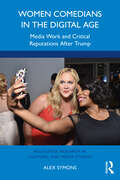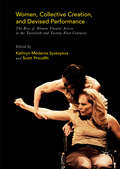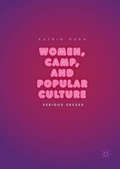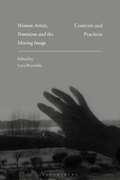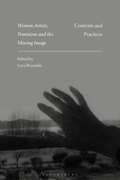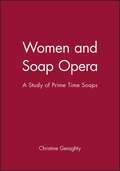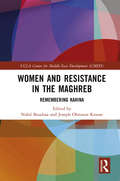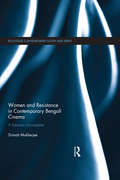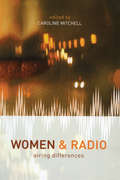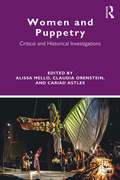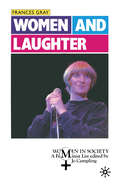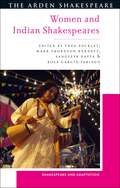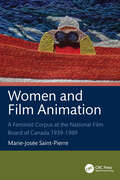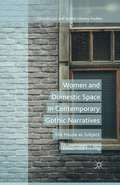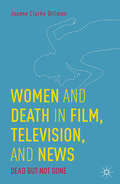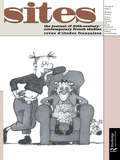- Table View
- List View
Women Comedians in the Digital Age: Media Work and Critical Reputations After Trump (Routledge Research in Cultural and Media Studies)
by Alex SymonsThis book offers a thorough examination of digital work by women comedians in the US, exploring their use of digital media to perform jokes, engage with fans, remake their reputations, and become political activists. This book argues that despite its many adverse effects, digital work is changing comedy, empowering women to create new comic forms and negotiate the contentious political climate incited by former President Donald. J. Trump. Chapters are focused on video podcasting, TikTok, Twitter, Instagram, YouTube, and the streaming platform Netflix – each containing informative case studies on significant women comedians who use them, including Sarah Silverman, Amy Schumer, Leslie Jones, Mindy Kaling, Colleen Ballinger, Lilly Singh, Ms. Pat, Whitney Cummings, Issa Rae, and others. To understand their strategies, this book examines the popularity of their digital content, their career outcomes in television and film, as well as the ups and downs of their critical reputations in magazines, newspapers, the trade press, and with their participatory audiences online. This insightful and timely work will appeal to scholars researching and teaching in the areas of media studies, digital communication, gender studies, and performance.
Women Comedians in the Digital Age: Media Work and Critical Reputations After Trump (Routledge Research in Cultural and Media Studies)
by Alex SymonsThis book offers a thorough examination of digital work by women comedians in the US, exploring their use of digital media to perform jokes, engage with fans, remake their reputations, and become political activists. This book argues that despite its many adverse effects, digital work is changing comedy, empowering women to create new comic forms and negotiate the contentious political climate incited by former President Donald. J. Trump. Chapters are focused on video podcasting, TikTok, Twitter, Instagram, YouTube, and the streaming platform Netflix – each containing informative case studies on significant women comedians who use them, including Sarah Silverman, Amy Schumer, Leslie Jones, Mindy Kaling, Colleen Ballinger, Lilly Singh, Ms. Pat, Whitney Cummings, Issa Rae, and others. To understand their strategies, this book examines the popularity of their digital content, their career outcomes in television and film, as well as the ups and downs of their critical reputations in magazines, newspapers, the trade press, and with their participatory audiences online. This insightful and timely work will appeal to scholars researching and teaching in the areas of media studies, digital communication, gender studies, and performance.
Women, Collective Creation, and Devised Performance: The Rise of Women Theatre Artists in the Twentieth and Twenty-First Centuries
by Kathryn Mederos Syssoyeva Scott ProudfitThis book explores the role and centrality of women in the development of collaborative theatre practice, alongside the significance of collective creation and devising in the development of the modern theatre. Tracing a web of women theatremakers in Europe and North America, this book explores the connections between early twentieth century collective theatre practices such as workers theatre and the dramatic play movement, and the subsequent spread of theatrical devising. Chapters investigate the work of the Settlement Houses, total theatre in 1920s’ France, the mid-century avant-garde and New Left collectives, the nomadic performances of Europe’s transnational theatre troupes, street-theatre protests, and contemporary devising. In so doing, the book further elucidates a history of modern theatre begun in A History of Collective Creation (2013) and Collective Creation in Contemporary Performance (2013), in which the seemingly marginal and disparate practices of collective creation and devising are revealed as central—and women theatremakers revealed as progenitors of these practices.
Women, Camp, and Popular Culture: Serious Excess
by Katrin HornThis innovative study claims camp as a critical, yet pleasurable strategy for women’s engagement with contemporary popular culture as exemplified by 30 Rock or Lady Gaga. In detailed analyses of lesbian cinema, postfeminist TV, and popular music, the book offers a novel take on its subject. It defines camp as a unique mode of detached attachment, which builds on affective intensity and emotional investment, while strongly encouraging a critical edge.
Women, Camp, and Popular Culture: Serious Excess
by Katrin HornThis innovative study claims camp as a critical, yet pleasurable strategy for women’s engagement with contemporary popular culture as exemplified by 30 Rock or Lady Gaga. In detailed analyses of lesbian cinema, postfeminist TV, and popular music, the book offers a novel take on its subject. It defines camp as a unique mode of detached attachment, which builds on affective intensity and emotional investment, while strongly encouraging a critical edge.
Women Artists, Feminism and the Moving Image: Contexts and Practices (International Library Of The Moving Image Ser.)
by Lucy ReynoldsWhat is the significance of gendered identification in relation to artists' moving image? How do women artists grapple with the interlinked narratives of gender discrimination and gender identity in their work? In this groundbreaking book, a diverse range of leading scholars, activists, archivists and artists explore the histories, practices and concerns of women making film and video across the world, from the pioneering German animator Lotte Reiniger, to the influential African American filmmaker Julie Dash and the provocative Scottish contemporary artist Rachel Maclean. Opening with a foreword from the film theorist Laura Mulvey and a poem by the artist film-maker Lis Rhodes, Women Artists, Feminism and the Moving Image traces the legacies of early feminist interventions into the moving image and the ways in which these have been re-configured in the very different context of today. Reflecting and building upon the practices of recuperation that continue to play a vital role in feminist art practice and scholarship, essays discuss topics such as how multiculturalism is linked to experimental and activist film history, the function and nature of the essay film, feminist curatorial practices and much more. This book transports the reader across diverse cultural contexts and geographical contours, addressing complex narratives of subjectivity, representation and labour, while juxtaposing cultures of film, video and visual arts practice often held apart. As the editor, Lucy Reynolds, argues: it is at the point where art, moving image and feminist discourse converge that a rich and dynamic intersection of dialogue and exchange opens up, bringing to attention practices which might fall outside their separate spheres, and offering fresh perspectives and insights on those already established in its histories and canons.
Women Artists, Feminism and the Moving Image: Contexts and Practices
What is the significance of gendered identification in relation to artists' moving image? How do women artists grapple with the interlinked narratives of gender discrimination and gender identity in their work? In this groundbreaking book, a diverse range of leading scholars, activists, archivists and artists explore the histories, practices and concerns of women making film and video across the world, from the pioneering German animator Lotte Reiniger, to the influential African American filmmaker Julie Dash and the provocative Scottish contemporary artist Rachel Maclean. Opening with a foreword from the film theorist Laura Mulvey and a poem by the artist film-maker Lis Rhodes, Women Artists, Feminism and the Moving Image traces the legacies of early feminist interventions into the moving image and the ways in which these have been re-configured in the very different context of today. Reflecting and building upon the practices of recuperation that continue to play a vital role in feminist art practice and scholarship, essays discuss topics such as how multiculturalism is linked to experimental and activist film history, the function and nature of the essay film, feminist curatorial practices and much more. This book transports the reader across diverse cultural contexts and geographical contours, addressing complex narratives of subjectivity, representation and labour, while juxtaposing cultures of film, video and visual arts practice often held apart. As the editor, Lucy Reynolds, argues: it is at the point where art, moving image and feminist discourse converge that a rich and dynamic intersection of dialogue and exchange opens up, bringing to attention practices which might fall outside their separate spheres, and offering fresh perspectives and insights on those already established in its histories and canons.
Women And Soap Opera: A Study Of Prime Time Soaps (Social Psychology And Society Ser.)
by Christine GeraghtyThis is the first major study of the roles of women in prime time soap operas. In a comparative analysis of British and North American television soaps, Christine Geraghty examines the relationship between the narratives on the screen and the women viewers who make up the traditional soap audience. Within the structure of many of the most popular soaps, such as Dallas, Dynasty, Coronation Street and EastEnders, the split between public and personal life, reason and emotion, work and leisure is turned into a lynchpin of the plot. The author argues that these themes are also linked to broader social divisions between men and women, divisions which soap operas both question and develop as a source of pleasure. Geraghty analyses the critical role of women characters in the families and communities of soaps and suggests that the utopian possibilities of soaps can be used not just to maintain the status quo, but to promote change and influence attitudes and prejudices. She examines the way in which soaps have been transformed in the last decade, looking at how issues of class, race, sexual orientation and feminism have been handled in the programmes. She argues that in pursuing new audiences more recent soaps such as Brookside may have put at risk the pleasures they have traditionally offered their women viewers. Women and Soap Opera is a detailed, thoughtful and wide-ranging analysis which will become a central work in women's studies and media and cultural studies courses.
Women and Resistance in the Maghreb: Remembering Kahina (UCLA Center for Middle East Development (CMED))
by Nabil BoudraaThis book studies women’s resistance in the three countries of the Maghreb, concentrating on two questions: First, what has been the role of women artists since the 1960s in unlocking traditions and emancipating women on their own terms? Second, why have Maghrebi women rarely been given the right to be heard since Algeria, Morocco, and Tunisia gained national independence? Honouring the artistic voices of women that have been largely eclipsed from both popular culture and political discourse in the Maghreb, the work specifically examines resistance by women since 1960s in the Maghreb through cinema, politics, and the arts. In an ancillary way, the volume addresses a wide range of questions that are specific to Maghrebi women related to upbringing, sexuality, marriage, education, representation, exclusion, and historical memory. These issues, in their broadest dimensions, opened the gates to responses in different fields in both the humanities and the social sciences. The research presents scholarship by not only leading scholars in Francophone studies, cultural history, and specialists in women studies, but also some of the most important film critics and practicing feminist advocates. The variety of periods and disciplines in this collection allow for a coherent and general understanding of Maghrebi societies since decolonization. The volume is a key resource to students and scholars interested in women’s studies, the Maghreb, and Middle East studies.
Women and Resistance in the Maghreb: Remembering Kahina (UCLA Center for Middle East Development (CMED))
by Nabil Boudraa Joseph Ohmann KrauseThis book studies women’s resistance in the three countries of the Maghreb, concentrating on two questions: First, what has been the role of women artists since the 1960s in unlocking traditions and emancipating women on their own terms? Second, why have Maghrebi women rarely been given the right to be heard since Algeria, Morocco, and Tunisia gained national independence? Honouring the artistic voices of women that have been largely eclipsed from both popular culture and political discourse in the Maghreb, the work specifically examines resistance by women since 1960s in the Maghreb through cinema, politics, and the arts. In an ancillary way, the volume addresses a wide range of questions that are specific to Maghrebi women related to upbringing, sexuality, marriage, education, representation, exclusion, and historical memory. These issues, in their broadest dimensions, opened the gates to responses in different fields in both the humanities and the social sciences. The research presents scholarship by not only leading scholars in Francophone studies, cultural history, and specialists in women studies, but also some of the most important film critics and practicing feminist advocates. The variety of periods and disciplines in this collection allow for a coherent and general understanding of Maghrebi societies since decolonization. The volume is a key resource to students and scholars interested in women’s studies, the Maghreb, and Middle East studies.
Women and Resistance in Contemporary Bengali Cinema: A Freedom Incomplete (Routledge Contemporary South Asia Series)
by Srimati MukherjeeHistorically, Indian cinema has positioned women at the intersection of tradition and a more evolving culture, portraying contradictory attitudes which affect women’s roles in public and private spheres. Examining the work of three directors from West Bengal, this book addresses the juxtaposition of tradition and culture regarding women in Bengali cinema. It argues the antithesis of women’s roles, particularly in terms of ideas of resistance, revolution, change, and autonomy, by suggesting they convey resistance to hegemonic structures, encouraging a re-envisioning of women’s positions within the familial-social matrix. Along with presenting a perception of culture as dynamic and evolving, the book discusses how some directors show that with this rupturing of the traditionally prohibitive, and a notion of unmaking and making in women, a traditional inclination is exposed to align women with ideas of absence, substitution, and disposability. The author goes on to show how selected auteurs in contemporary Bengali cinema break with certain traditional representations of women, gesturing towards a culture that is more liberating for women. Presenting the first full-length study of women’s changing roles over the last twenty years of Bengali cinema, this book will be a useful contribution for students and scholars of South Asian Culture, Film Studies and Gender Studies.
Women and Resistance in Contemporary Bengali Cinema: A Freedom Incomplete (Routledge Contemporary South Asia Series)
by Srimati MukherjeeHistorically, Indian cinema has positioned women at the intersection of tradition and a more evolving culture, portraying contradictory attitudes which affect women’s roles in public and private spheres. Examining the work of three directors from West Bengal, this book addresses the juxtaposition of tradition and culture regarding women in Bengali cinema. It argues the antithesis of women’s roles, particularly in terms of ideas of resistance, revolution, change, and autonomy, by suggesting they convey resistance to hegemonic structures, encouraging a re-envisioning of women’s positions within the familial-social matrix. Along with presenting a perception of culture as dynamic and evolving, the book discusses how some directors show that with this rupturing of the traditionally prohibitive, and a notion of unmaking and making in women, a traditional inclination is exposed to align women with ideas of absence, substitution, and disposability. The author goes on to show how selected auteurs in contemporary Bengali cinema break with certain traditional representations of women, gesturing towards a culture that is more liberating for women. Presenting the first full-length study of women’s changing roles over the last twenty years of Bengali cinema, this book will be a useful contribution for students and scholars of South Asian Culture, Film Studies and Gender Studies.
Women and Radio: Airing Differences
by Caroline MitchellCombining classic work on radio with innovative research, journalism and biography, Women and Radio offers a variety of approaches to understanding the position of women as producers, presenters and consumers as well as offering guidelines, advice and helpful information for women wanting to work in radio.Women and Radio examines the relationship between radio audiences, technologies and programming and reveals and explains the inequalities experienced by women working in the industry.
Women and Radio: Airing Differences
by Caroline MitchellCombining classic work on radio with innovative research, journalism and biography, Women and Radio offers a variety of approaches to understanding the position of women as producers, presenters and consumers as well as offering guidelines, advice and helpful information for women wanting to work in radio.Women and Radio examines the relationship between radio audiences, technologies and programming and reveals and explains the inequalities experienced by women working in the industry.
Women and Puppetry: Critical and Historical Investigations
by Alissa Mello Claudia Orenstein Cariad AstlesWomen and Puppetry is the first publication dedicated to the study of women in the field of puppetry arts. It includes critical articles and personal accounts that interrogate specific historical moments, cultural contexts, and notions of "woman" on and off stage. Part I, "Critical Perspective," includes historical and contemporary analyses of women’s roles in society, gender anxiety revealed through the unmarked puppet body, and sexual expression within oppressive social contexts. Part II, "Local Contexts: Challenges and Transformations," investigates work of female practitioners within specific cultural contexts to illuminate how women are intervening in traditionally male spaces. Each chapter in Part II offers brief accounts of specific social histories, barriers, and gender biases that women have faced, and the opportunities afforded female creative leaders to appropriate, revive, and transform performance traditions. And in Part III, "Women Practitioners Speak," contemporary artists reflect on their experiences as female practitioners within the art of puppet theatre. Representing female writers and practitioners from across the globe, Women and Puppetry offers students and scholars a comprehensive interrogation of the challenges and opportunities that women face in this unique art form.
Women and Puppetry: Critical and Historical Investigations
by Alissa Mello Claudia Orenstein Cariad AstlesWomen and Puppetry is the first publication dedicated to the study of women in the field of puppetry arts. It includes critical articles and personal accounts that interrogate specific historical moments, cultural contexts, and notions of "woman" on and off stage. Part I, "Critical Perspective," includes historical and contemporary analyses of women’s roles in society, gender anxiety revealed through the unmarked puppet body, and sexual expression within oppressive social contexts. Part II, "Local Contexts: Challenges and Transformations," investigates work of female practitioners within specific cultural contexts to illuminate how women are intervening in traditionally male spaces. Each chapter in Part II offers brief accounts of specific social histories, barriers, and gender biases that women have faced, and the opportunities afforded female creative leaders to appropriate, revive, and transform performance traditions. And in Part III, "Women Practitioners Speak," contemporary artists reflect on their experiences as female practitioners within the art of puppet theatre. Representing female writers and practitioners from across the globe, Women and Puppetry offers students and scholars a comprehensive interrogation of the challenges and opportunities that women face in this unique art form.
Women and Migration in Contemporary Italian Cinema: Screening Hospitality (Transnational Italian Cultures #7)
by Giovanna Faleschini LernerWomen and Migration in Contemporary Italian Cinema: Screening Hospitality puts gender at the centre of cinematic representations of contemporary transnational Italian identities. It offers an intersectional feminist analysis of the ways in which transnational migration has been represented, understood, and constructed in the contemporary cinema of Italy. Drawing on Jacques Derrida’s notion of hospitality and in dialogue with postcolonial and decolonial theory, queer studies, and feminist critiques, the six chapters of the book focus on a series of exemplary fiction films from the last twenty years, which both reflect and shape the nation’s responses to the growing presence of transnational migrants in Italian society. The book shows how questions of gender, sexual difference, and reproductivity have been central to Italian filmmakers’ approaches to stories of mobility and displacement. Gender is also enmeshed in the rhetoric and poetic of hospitality that filmmakers propose as a critical framework to condemn Italian border policies and politics. Women and Migration in Contemporary Italian Cinema: Screening Hospitality traces an arc that moves from the embrace of a humanitarian rhetoric of infinite hospitality toward migrants, apparent in films produced in the early 2000s, to a more fluid understanding of Italian identities from a transnational perspective.
Women and Laughter (Women in Society: A Feminist List)
by Frances GrayTraditionally women have no sense of humour. This book explodes the myth by explaining the impact of women on popular comedy as sitcom stars and as standup comics. It also looks at the implications of the myth itself, and its serious consequences for women politically as well as socially.
Women and Indian Shakespeares (Shakespeare and Adaptation)
by Mark Thornton BurnettWomen and Indian Shakespeares explores the multiple ways in which women, and those identifying as women, are, and have been, engaged with Shakespeare in India. Women's engagements encompass the full range of media, from translation to cinematic adaptation and from early colonial performance to contemporary theatrical experiment. Simultaneously, Women and Indian Shakespeares makes visible the ways in which women are figured in various representational registers as resistant agents, martial seductresses, redemptive daughters, victims of caste discrimination, conflicted spaces and global citizens. In so doing, the collection reorients existing lines of investigation, extends the disciplinary field, brings into visibility still occluded subjects and opens up radical readings. More broadly, the collection identifies how, in Indian Shakespeares on page, stage and screen, women increasingly possess the ability to shape alternative futures across patriarchal and societal barriers of race, caste, religion and class. In repeated iterations, the collection turns our attention to localized modes of adaptation that enable opportunities for women while celebrating Shakespeare's gendered interactions in India's rapidly changing, and increasingly globalized, cultural, economic and political environment. In the contributions, we see a transformed Shakespeare, a playwright who appears differently when seen through the gendered eyes of a new Indian, diasporic and global generation of critics, historians, archivists, practitioners and directors. Radically imagining Indian Shakespeares with women at the centre, Women and Indian Shakespeares interweaves history, regional geography/regionality, language and the present day to establish a record of women as creators and adapters of Shakespeare in Indian contexts.
Women and Indian Shakespeares (Shakespeare and Adaptation)
by Mark Thornton BurnettWomen and Indian Shakespeares explores the multiple ways in which women, and those identifying as women, are, and have been, engaged with Shakespeare in India. Women's engagements encompass the full range of media, from translation to cinematic adaptation and from early colonial performance to contemporary theatrical experiment. Simultaneously, Women and Indian Shakespeares makes visible the ways in which women are figured in various representational registers as resistant agents, martial seductresses, redemptive daughters, victims of caste discrimination, conflicted spaces and global citizens. In so doing, the collection reorients existing lines of investigation, extends the disciplinary field, brings into visibility still occluded subjects and opens up radical readings. More broadly, the collection identifies how, in Indian Shakespeares on page, stage and screen, women increasingly possess the ability to shape alternative futures across patriarchal and societal barriers of race, caste, religion and class. In repeated iterations, the collection turns our attention to localized modes of adaptation that enable opportunities for women while celebrating Shakespeare's gendered interactions in India's rapidly changing, and increasingly globalized, cultural, economic and political environment. In the contributions, we see a transformed Shakespeare, a playwright who appears differently when seen through the gendered eyes of a new Indian, diasporic and global generation of critics, historians, archivists, practitioners and directors. Radically imagining Indian Shakespeares with women at the centre, Women and Indian Shakespeares interweaves history, regional geography/regionality, language and the present day to establish a record of women as creators and adapters of Shakespeare in Indian contexts.
Women and Film Animation: A Feminist Corpus at the National Film Board of Canada 1939-1989
by Marie-Josée Saint-PierreThe creations of female animation filmmakers are recognized all over the world while being, paradoxically, unknown to the general public. Women and Film Animation: A Feminist Corpus at the National Film Board of Canada 1939-1989 brings out of the shadows the work of true pioneers by presenting and analyzing, from a resolutely feminist perspective, the works they have conceived within the National Film Board of Canada (NFB).This institution has played an essential role in the emergence of animated cinema in Canada, but it is forgotten or ignored that a good part of this vast corpus is the work of women who have worked there not only as assistants but also as directors. These artists have contributed to changing the traditional representations of women in a unique way in both commercial and avant-garde animated cinema. The author accounts for their concerns, their creativity, and their many bright achievements. To do this, she relies on a wide range of critical works in social and cultural history of Canada, in feminist art history, and on multiple studies on animated cinema.Key Features: Provides an interdisciplinary approach that combines concepts from feminist studies, film theory and visual arts for a nuanced analysis of the role of women in animated cinema Discusses historical and sociological background that sheds light on the condition of women Includes a profound analysis of the changes and continuities in the role of women in this industry over time, focusing on the National Film Board of Canada Features previously unreleased archival material and selected excerpts from reviews by the NFB’s programming committee, highlighting the impact of production circumstances of the works of specific women animators
Women and Film Animation: A Feminist Corpus at the National Film Board of Canada 1939-1989
by Marie-Josée Saint-PierreThe creations of female animation filmmakers are recognized all over the world while being, paradoxically, unknown to the general public. Women and Film Animation: A Feminist Corpus at the National Film Board of Canada 1939-1989 brings out of the shadows the work of true pioneers by presenting and analyzing, from a resolutely feminist perspective, the works they have conceived within the National Film Board of Canada (NFB).This institution has played an essential role in the emergence of animated cinema in Canada, but it is forgotten or ignored that a good part of this vast corpus is the work of women who have worked there not only as assistants but also as directors. These artists have contributed to changing the traditional representations of women in a unique way in both commercial and avant-garde animated cinema. The author accounts for their concerns, their creativity, and their many bright achievements. To do this, she relies on a wide range of critical works in social and cultural history of Canada, in feminist art history, and on multiple studies on animated cinema.Key Features: Provides an interdisciplinary approach that combines concepts from feminist studies, film theory and visual arts for a nuanced analysis of the role of women in animated cinema Discusses historical and sociological background that sheds light on the condition of women Includes a profound analysis of the changes and continuities in the role of women in this industry over time, focusing on the National Film Board of Canada Features previously unreleased archival material and selected excerpts from reviews by the NFB’s programming committee, highlighting the impact of production circumstances of the works of specific women animators
Women and Domestic Space in Contemporary Gothic Narratives: The House as Subject (Geocriticism and Spatial Literary Studies)
by A. Soon Andrew Hock Soon NgMoving away from traditional studies of Gothic domesticity based on symbolism, Soon instead focuses on domestic space's material presence and the traces it leaves on the human subjects inhabiting it. Approaching novels and films such as Beloved and The Exorcist , this study intersects psychoanalysis, phenomenology, and various spatial theories.
Women and Death in Film, Television, and News: Dead but Not Gone
by Joanne Clarke DillmanDead women litter the visual landscape of the 2000s. In this book, Clarke Dillman explains the contextual environment from which these images have arisen, how the images relate to (and sometimes contradict) the narratives they help to constitute, and the cultural work that dead women perform in visual texts.
Women
by Roger CélestinPublished in 2001, Women is a valuable contribution to the field of Performance.
